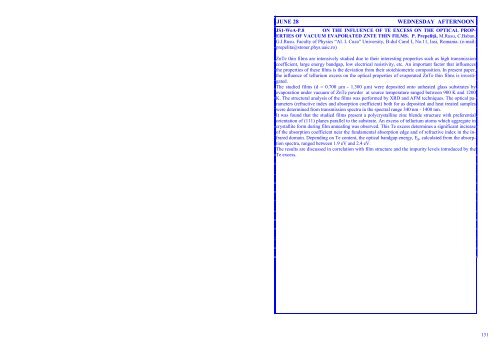Wüest M. 51 Wykes M. 82 Yamaguchi M. 17 Ybarra G. 129 Yubero F ...
Wüest M. 51 Wykes M. 82 Yamaguchi M. 17 Ybarra G. 129 Yubero F ...
Wüest M. 51 Wykes M. 82 Yamaguchi M. 17 Ybarra G. 129 Yubero F ...
You also want an ePaper? Increase the reach of your titles
YUMPU automatically turns print PDFs into web optimized ePapers that Google loves.
JUNE 28 WEDNESDAY AFTERNOON<br />
JS1-WeA-P.8 ON THE INFLUENCE OF TE EXCESS ON THE OPTICAL PROP-<br />
ERTIES OF VACUUM EVAPORATED ZNTE THIN FILMS. P. Prepeliţă, M.Rusu, C.Baban,<br />
G.I.Rusu. Faculty of Physics “Al. I. Cuza” University, B-dul Carol I, No.11, Iasi, Romania. (e-mail:<br />
prepelita@stoner.phys.uaic.ro)<br />
ZnTe thin films are intensively studied due to their interesting properties such as high transmission<br />
coefficient, large energy bandgap, low electrical resistivity, etc. An important factor that influences<br />
the properties of these films is the deviation from their stoichiometric composition. In present paper,<br />
the influence of tellurium excess on the optical properties of evaporated ZnTe thin films is investigated.<br />
The studied films (d = 0.700 µm - 1.300 µm) were deposited onto unheated glass substrates by<br />
evaporation under vacuum of ZnTe powder at source temperature ranged between 900 K and 1200<br />
K. The structural analysis of the films was performed by XRD and AFM techniques. The optical parameters<br />
(refractive index and absorption coefficient) both for as deposited and heat treated samples<br />
were determined from transmission spectra in the spectral range 340 nm - 1400 nm.<br />
It was found that the studied films present a polycrystalline zinc blende structure with preferential<br />
orientation of (111) planes parallel to the substrate. An excess of tellurium atoms which aggregate in<br />
crystallite form during film annealing was observed. This Te excess determines a significant increase<br />
of the absorption coefficient near the fundamental absorption edge and of refractive index in the infrared<br />
domain. Depending on Te content, the optical bandgap energy, E g , calculated from the absorption<br />
spectra, ranged between 1.9 eV and 2.4 eV.<br />
The results are discussed in correlation with film structure and the impurity levels introduced by the<br />
Te excess.<br />
131
















